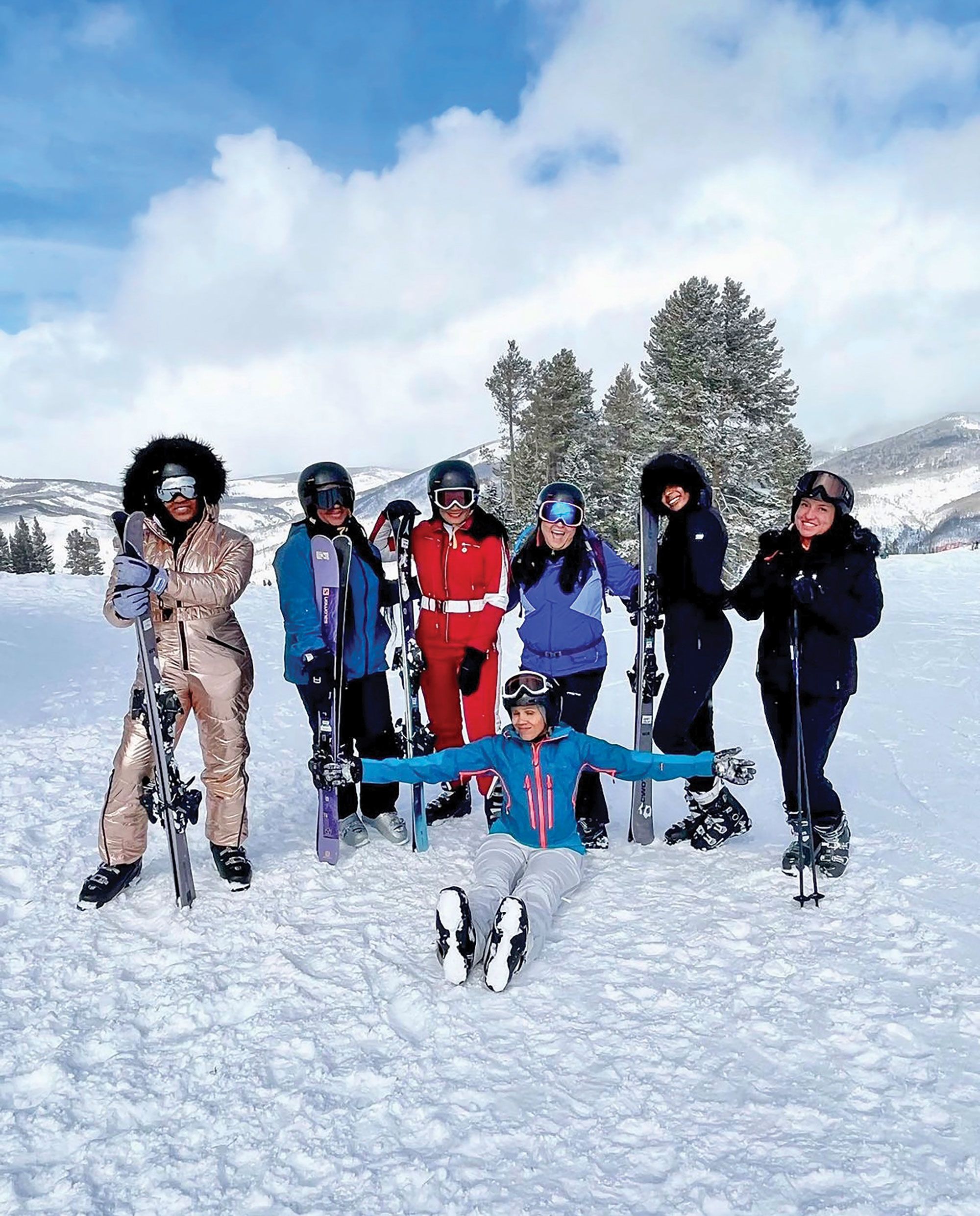Black travel: inclusion in action
From the ski slopes of Vail to the Lowcountry of South Carolina, the travel industry is making strides in increasing the representation and inclusion of Black travelers. Here’s what that means — and why it matters.

Many people know by now that representation of Black travelers — in media, in promotional material — matters to Black travelers.
Seeing that imagery in any place where travel is happening, be it the far-flung corners of the Antarctic or the cobblestoned streets of medieval Europe, is important. But seeing that reality reflected not just in travel marketing campaigns but in the creation and production of actual travel experiences also matters deeply.
Calls from the Black travel market and Black travel professionals for better industry representation have not gone unheard by suppliers. Some have undertaken meaningful efforts to offer experiences curated with the Black traveler in mind. Others, through partnerships with Black-owned businesses and organizations, have leveraged the prominence of their brands to increase the visibility of the Black travel market.
Among the signs of progress: Later this year, AmaWaterways is slated to debut the first Black heritage river cruise itinerary, and Intrepid Travel has forged a partnership with a Black-owned tour operator to bring Black history in America to a global audience.
Slowly but surely, the travel industry is catching up to the Black travel market, going beyond just minimal cosmetic efforts to create offerings and partnerships that dive deeper into a community that has long awaited, and has certainly deserved, meaningful change and attention.

Vrbo partnership with the National Brotherhood of Skiers
I was on a press ski trip in Vail, Colo., in early February for the 50th anniversary summit of the National Brotherhood of Skiers (NBS), a nonprofit whose aim is to support and promote the presence of people of color on the slopes and to train top athletes to compete at the Olympic level.
Thousands of Black skiers had poured into Vail Village, carrying signs and flags emblazoned with the names of the 50-plus NBS chapters nationwide. I stood in awe as one group after the other paraded into the village with the energy of a New Orleans second line, marching to the decades-spanning hits of famous Black artists.
“Soul on Snow,” the name of this year’s event, could not have been more fitting. And I could not have felt more moved seeing so many Black faces in this particular ski resort, where I knew this sight was not the norm.
No one at the summit — including the leadership of Vail Mountain and Vail Resorts — shied away from acknowledging Vail’s image as a high-end ski resort that has historically catered to a predominantly white demographic.
NBS president Henri Rivers, noting that the group is “the largest Black ski and snowsports organization in the world,” said more than 2,000 Black skiers attended this year’s summit.
The host location was not an arbitrary decision.
“If you want us to come here and stay here, it’s got to be reflected in your operational structure,” Rivers said of the way he determines whether a destination is the right fit for NBS events. “Inclusion doesn’t equal lift ticket sales and more tickets to Black skiers. Inclusion to me starts from the bottom up, and from the top down. I want to see more managers of color, people in hospitality running that section of the business, people in ski school operations.”
Efforts like these are ones that Vail has consistently made, Rivers said, which is why the relationship NBS has with Vail Resorts has been reflective of what the organization stands for.
“Vail Resorts has about three, four, five upper-level positions that are filled by people of color. I’ve gotten many commitments from their CEO that, when they can fill a position, they’re definitely going to look at that,” Rivers said, adding that ties have also been strengthened with partnerships that Vail Resorts has formed with other community organizations to help grow NBS’s winter outreach programs.
“The future of skiing is inclusion,” said Beth Howard, COO of Vail Mountain. “We want everyone to feel welcome to the sport. We need that diversity. It shouldn’t be intimidating, it should be welcoming. We want you to feel that you have a sense of belonging.”
I likely would have never discovered the NBS this year if it hadn’t been for Vrbo, which partnered with the organization for the first time and organized the press trip to showcase the group’s milestone celebration.
It was especially meaningful to have been on a press trip purposefully made up of all Black, female journalists and travel influencers. We had numerous conversations about our shared and unique experiences as Black women in media and as Black women in life. Our discussions were emotional and powerful.
The fact that we were all in the same room having those conversations was not lost on us; whatever challenges we had faced on our different paths led to the successes that brought us all to Vail and that we now enjoyed.
It’s this exact environment of connection among Black travelers that Expedia Group, parent company of Vrbo, was trying to foster through its latest progressive initiative.
“We recently launched our Black and Well-Traveled concept at Afrotech, focused on building community and access for Black travelers while centering and elevating their experiences,” said Alexandra Legend Siegel, vice president of global diversity and inclusion for Expedia Group, who had joined our press group in Vail.
“It is important for us to elevate the incredible work and legacy of NBS while authentically connecting with the Black traveler and skier community,” Siegel added. “We were honored to host and learn from our Black writers who joined Vrbo, as we believe in centering Black voices and stories.”

Black Cultural Heritage Tours
In January, I joined a Black Cultural Heritage Tours itinerary to South Carolina, and there was a different choreography, a different rhythm, on that trip.
The focus and name of that six-day itinerary was Charleston to Savannah: Exploring the Gullah Geechee Corridor.
We set out to learn about the Gullah Geechee people, the descendants of the first West Africans brought to America and forced into slavery. Their communities today still span the southern Atlantic coastline where their ancestors had originally arrived.
It was the first official look at a tour that Stephanie Jones and her team at the Cultural Heritage Economic Alliance had spent over a year crafting, with the support of Intrepid Travel.
“Stephanie was brilliant. She was so committed to the story being told from a local’s perspective and not through a white lens,” said Matt Berna, North America president for Intrepid Travel. “She went out and found business partners and storytellers and artists and chefs that could help tell that story to us. That’s the important part. That’s the impact.”
From Al Miller’s Sites and Insights bus tour around the Sea Islands of Charleston to the sweet grass basket-weaving demonstration with Lucille Smith and the Lowcountry boil we were treated to by the Gullah Geechee Cultural Center, there was a cadence between the visits we made that was much like the call-and-response rhythm commonly found in the spirituals that had roots in this region.
It’s as if, without knowing it, the storytellers spoke to each other and, in turn, were able to speak to us in ways that went deep, well beyond the lessons and information you might pick up on a traditional tour.
It’s exactly that goal that Jones set when she created Black Cultural Heritage Tours: She wanted to offer to travelers interested in Black heritage a range of experiences that went beyond the Civil Rights Movement. While the movement represents an important period, its overemphasis in other Black history tour programs can lead many travelers to misconstrue that civil rights is all there is to Black history in America.
“The influence of the Gullah culture is tied to everything that we do in this country. Most people eat rice, but most people don’t know that West Africans were the ones who brought rice over to our country,” Jones said. “There are so many other contributions that the Gullah have made.”
And the help and support of Intrepid Travel was pivotal. It was significant that one of the largest tour operators in the world partnered with Jones to operate the tours and bring these stories of the Black experience and history in America to a wider audience.
“We’re trying to create some economic benefit that’s going to go into Black businesses and Black communities through these itineraries,” Jones said. “Not every operator cares about that, but Intrepid does.”

Pride in Black travel
What’s been most surprising to learn over the past few months is how much the representation of Black travelers anywhere and everywhere has mattered to me personally.
Trips where the Black experience was at the center enlivened in me something I thought was achieved only through work I had done with my own hands: pride.
It was a kind of pride that comes from seeing that you’re part of something bigger than yourself, something stronger than the challenges you’ve faced. Your presence in this space is representative of what it took to get there, and when you are Black, you know it probably means that it took a lot.
Pride found its way to me as I witnessed both an industry rising to the challenge of embracing the Black traveler and the work of people ensuring their visibility. It reiterates the value of the Black community in places where they have always been but hadn’t always been seen.
It’s the inclusion of Black history, culture, art and people in travel products and in destinations — especially those thought to be devoid of a Black presence — that underscores the simple truths of what this kind of representation says to anyone within reach: Black travelers are everywhere. Black travelers are valued. And Black travelers matter to us.

